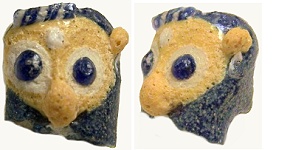Fine Coins Showcase
Antiquities Showcase
Show Empty Categories
Shop Search
Shopping Cart
My FORVM
Contact Us
About Forum
Shopping at Forum
Our Guarantee
Payment Options
Shipping Options & Fees
Privacy & Security
Forum Staff
Selling Your Coins
Identifying Your Coin
FAQs
zoom.asp
Home ▸ Catalog ▸ |Antiquities| ▸ |Antiquities by Type| ▸ |Amulets||View Options:   | | | | | | An amulet is a talisman or charm worn by an individual, and believed to have magical powers. Three of the four Egyptian words for amulet come from a word meaning "to guard and protect." Mesopotamian amulets were carved in stone in the forms of animals. Luristan and Amlash produced bronze amuletic animals in the 9th-7th century B.C. Egyptian amulets are the most collected and available of ancient amulets. They were produced from the Pre-Dynastic period through Roman times, a period of about 4500 years, intended to protect the individual both in this life and in the afterlife. Shell and ivory Pre-Dynastic amulets were made depicting hippopotami, antelope heads, lions, dogs, and bulls. By the end of this period, stone amulets were commonly adorned. From the Old Kingdom on, a vast array of amulets of gods, goddess, and sacred animals were produced in many media, including faience. Amulets of protection were inanimate forms such as Ujat, the eye of Horus. The Ujat was used to ward off evil, and for healing. Amulets of assimilation were produced to help the wearer take on qualities that the amulet represented. For example, a hare amulet would confer swiftness of movement and keenness of senses. Amulets of power were inanimate objects that conveyed royal and divine powers, and cosmic associations. A Crown of Lower Egypt amulet, for example, imbued authority and power. The amulets of offerings, possessions, and property acted as the substitutes for the wearer in the afterlife. Roman amulets are often bronze. They depict gods, goddesses, and the erotic phallus, a symbol of fertility worn by the military for good luck. Faience amulets were produced in Roman Egypt and Roman Syria as well. Parthian bronze gazelle amulets were found in the excavations at Dura Europus. |


From the collection of Alex G. Malloy, former dealer in antiquities for 40 years.AM32371. Phoenician (Palestinian manufacture) glass head pendant, Choice, 1.9 cm (3/4"), white opaque glass face and black circular eyes white dot for chin, black hair top and loop for suspension, double headed with the same on the back side, complete and intact; very rare; SOLD
Egyptian, Beaded Horus Falcon Funerary Ornament, Ptolemaic Period, 304 - 30 B.C.


From the collection of Alex G. Malloy, former dealer in antiquities for 40 years.
This beaded Horus Falcon funerary ornament was likely placed on the chest of a mummy sheathed in strands of blue faience beads.AZ33398. Colorful beaded funerary ornament; cf. Alex G. Malloy, Ancient Art and Antiquities, Summer 1977, 17, Superb, 6 1/2" Horus Falcon with crowned head and spread wings, brightly colored turquoise blue, maroon, white, yellow, and black beads faience beads; intact with original strings; SOLD
Punic (Carthage or Syria Palaestina Coast), Glass Caricature Head Pendant, Late 6th - 5th Century B.C.


From the collection of Alex G. Malloy, former dealer in antiquities for 40 years.
A recent European auction listed a similar but complete piece with an estimate of 18,000 Euros! SH32405. Head pendant; cf. Corning Pre-Roman 214, Choice, 1.6 cm (5/8"), core-formed, yellow face and ears, white eyes with blue centers, white blob center of forehead, blue beard, blue and white spiral striped hair band, lower beard, back and loop missing; rare; SOLD

You are viewing a SOLD items page.
Click here to return to the page with AVAILABLE items.
The sale price for a sold item is the private information of the buyer and will not be provided.



REFERENCES
Page created in 1.125 seconds.






